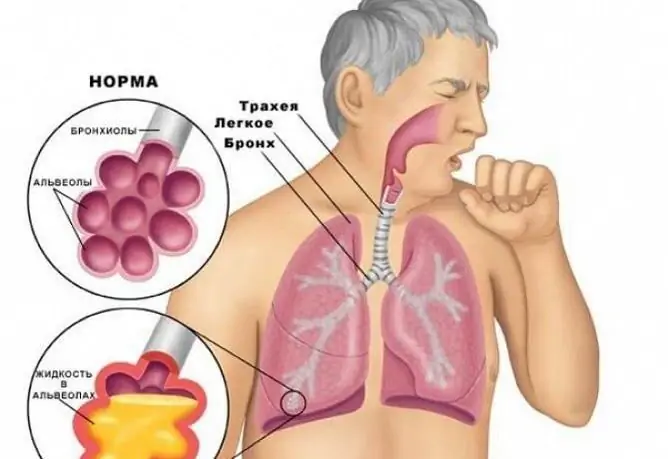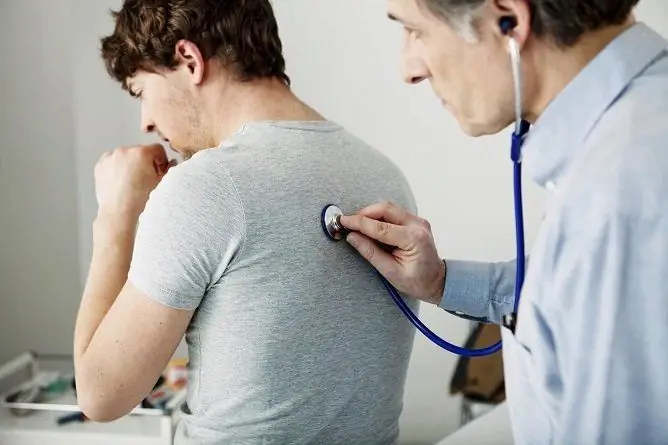- Author Rachel Wainwright [email protected].
- Public 2023-12-15 07:39.
- Last modified 2025-11-02 20:14.
How to distinguish bronchitis from pneumonia: differences in symptoms, causes of development, a different approach to treatment
The content of the article:
- Symptoms of bronchitis and pneumonia
- Can bronchitis turn into pneumonia
- Causes of bronchitis and pneumonia
- Approach to the treatment of bronchitis and pneumonia
- Video
How to distinguish bronchitis from pneumonia (pneumonia)? This is an urgent issue, since respiratory diseases, with the wrong approach to treatment, can lead to the development of severe complications.
Since it is far from always possible to distinguish bronchitis from pneumonia in a child and an adult at home, and self-medication is likely to lead to an aggravation of the patient's condition, if signs of any of these diseases appear, you should immediately consult a doctor, undergo the necessary examination, get an appointment and only after that start treatment.

The exact method to distinguish bronchitis from pneumonia is radiography
To make a diagnosis, complaints and anamnesis are collected, physical diagnostics, laboratory tests (blood tests, sputum). For the selection of antibiotics, the pathogen is isolated and its sensitivity is determined. The main method of differentiating bronchitis from pneumonia is X-ray examination.
Symptoms of bronchitis and pneumonia
In bronchitis, the pathological process occurs mainly in the mucous membrane of the bronchi, in pneumonia - in the alveoli and interstitial tissue of the lung. Since in both cases we are talking about an inflammatory process that occurs in the airways, some symptoms of bronchitis and pneumonia are similar.
For the onset of bronchitis, a deterioration in the general condition of the patient, the occurrence of a dry irritating cough, an increase in body temperature are characteristic, with infectious bronchitis there are signs of a respiratory infection. With the progression of the pathology (after a day or two), sputum begins to separate, while the cough becomes moist. In some cases, patients have chest pains, difficulty breathing, and dizziness. In chronic bronchitis, pallor and / or cyanosis of the skin is often observed.
In the early stages of pneumonia, symptoms of a respiratory infection may also occur. A patient with pneumonia complains of heaviness and / or pain in the chest, weakness, rapid breathing, high pulse, sweating, fever, which is usually higher than with bronchitis, and is accompanied by chills. Often, with the development of pneumonia, there is no effect of antipyretic drugs. When patients cough, a large amount of sputum is released.
Chest pain with pneumonia most often occurs on inspiration, and the cough can be painful. Pain in the chest usually occurs on one side and intensifies with a deep breath. There is pallor of the skin, chills, impaired appetite, headache.
The manifestations of pneumonia (especially in pediatric patients) include signs of oxygen deprivation due to a violation of gas exchange characteristic of this disease. The younger the children are, the more severe their illness is.
During auscultation with bronchitis, wheezing rales are usually heard, with pneumonia, wet and dry rales are determined.
Clinical signs of pneumonia can be observed for a long time, about a month, while bronchitis usually heals in two weeks.
Due to the peculiarities of the structure of the respiratory tract in children, edema of the bronchial mucosa develops quickly, the infection rapidly spreads further. In childhood, bronchopneumonia develops much more often, in which symptoms of both diseases are present in the clinical picture.
Only a qualified specialist can clarify the diagnosis.
Can bronchitis turn into pneumonia
Against the background of pneumonia, respiratory failure, abscess, exudative pleurisy may occur. Complications of bronchitis can be pulmonary emphysema, bronchial asthma, pulmonary hypertension, and pneumonia. Bronchitis that turns into pneumonia is not uncommon.
How to understand that bronchitis has turned into pneumonia? Usually this is indicated by the deterioration of the patient's condition, a persistent increase in body temperature, the ineffectiveness of antipyretic and other therapeutic agents, the appearance of signs of respiratory failure.
Causes of bronchitis and pneumonia
Bronchitis can be infectious or non-infectious, acute or chronic. The most common viral bronchitis, which develops against the background of ARVI, accounts for about 90% of all cases. In addition, the causative agents of bronchitis can be bacteria (much less frequently), fungi (very rarely). Atypical forms of bronchitis can be caused by microorganisms such as chlamydia, mycoplasma. Also, with bronchitis, it is possible to attach a secondary bacterial infection. Smoking, the presence of allergic processes, hypothermia, harmful working conditions, unfavorable environmental conditions, frequent diseases of the respiratory tract, and decreased immunity can contribute to the development of bronchitis.
Chronic bronchitis is said to be when the disease lasts at least 2 years with total periods of exacerbations of at least three months per year. The chronic form of bronchitis, as a rule, develops with improper treatment of the acute form or in the absence of therapy.
Pneumonia can be a complication of acute respiratory infections or bronchitis, but it can also occur on its own. Infectious agents of pneumonia are most often bacteria, less often viruses, microscopic fungi, parasites. In children under 5 years of age, the causative agent of pneumonia is most often Haemophilus influenzae or pneumococcus.

Young children often develop bronchopneumonia - a disease that has signs of both bronchitis and pneumonia
Approach to the treatment of bronchitis and pneumonia
Treatment of uncomplicated bronchitis is carried out at home, but it does not need to be carried on the legs, it is advisable to take sick leave for the entire duration of the illness. In the first few days of the disease, bed rest is recommended.
Inflammation of the lungs in most cases serves as an indication for hospitalization, especially for patients under 4 years of age. Just as with bronchitis, bed rest is required, but it lasts longer.
Both bronchitis and pneumonia of bacterial etiology require antibiotic therapy, the course of which is usually longer for pneumonia. Antibiotics are undesirable to use during pregnancy, and with bronchitis, the need for them rarely arises, with pneumonia, their use is necessary in almost all cases (with the exception of non-bacterial pneumonia). Otherwise, the risk of complications increases, which is worse for the health of the mother and fetus than the potential harm from drugs of this group.
At elevated body temperature (above 38 or 38.5 ° C in children and adults, respectively), antipyretic drugs are used. With bronchitis, expectorant, mucolytic drugs are prescribed (can be used in children from 3 years old). In severe cases of both bronchitis and pneumonia, steroid hormones and antihistamines may be prescribed. Pneumonia may be accompanied by oxygen deficiency, in such cases oxygen therapy is indicated. The need for it with bronchitis is extremely rare.
Video
We offer for viewing a video on the topic of the article.

Anna Aksenova Medical journalist About the author
Education: 2004-2007 "First Kiev Medical College" specialty "Laboratory Diagnostics".
Found a mistake in the text? Select it and press Ctrl + Enter.






